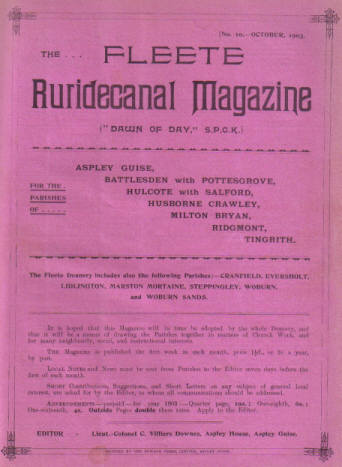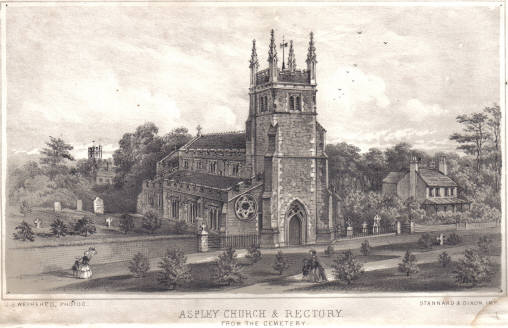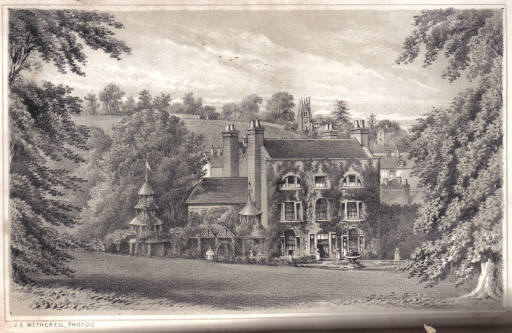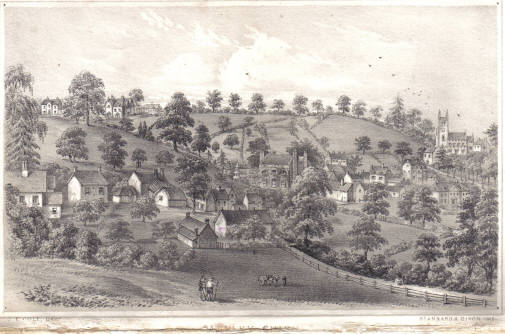Aspley Guise in 1835
These reminiscences were first published in the Fleete Ruridecanal Magazine in October, November and December 1903. Sadly, the author of the articles is not named, but the wealth of detail regarding 1835, and names here makes it very interesting.
The magazines were edited by Lieut. Col. C. Villiers Downes, of Aspley House, and have some lovely adverts for local firms, and news from the local churches. January 1903 is listed as the first issue, and it was printed by Powage Press in Aspley Guise.
It covered the parish and church news for Aspley Guise, Battlesden and Pottesgrove, Hulcote with Salford, Husborne Crawley, Milton Bryant, Ridgmont and Tinrith. It was pointed out that Lidlington, Marston Mortaine, Steppingley, Woburn and Woburn Sands are also part of the Fleete Deanery, and they would hopefully join in with the magazine in the future, yet by the end of that first year, none had.
There had been a Rurideanery Conference in Ridgmont in 1902, where Col. Downes put forward the idea of a magazine used by many parishes, so everyone would know what each others parishes were doing. 400 copies of the first issue were distributed.
All the issues for 1903 are bound up with a years’ worth of the periodical, “The Dawn of Day” magazine, which featured stories and poems with religious messages for Sunday School use.

The following local firms advertised each month: A. Boyes, bootmaker & clothier, Woburn Sands; McKay Bros, Drapers and clothiers, Woburn; A. Roberts, fishmonger and poulterer, Aspley Guise; M. Fleet, builder, Aspley Guise; George Whitman, house and estate agent, Aspley Guise; Charles Sinfield, builder, Aspley Guise; Thomas Wodhams, miller and corn agent, Woburn Sands; F. H. Day, grocer, Aspley Guise; J. F. Smith, plumber, Aspley Guise; J. McMurtrie, furnishings, Woburn Sands, Gregory, stationer, Woburn Sands; and Charles Minter, coin collector, Aspley Guise. There was also an advert for the newly opened Aspley Guise Parish Hall.
Aspley Guise Seventy Years Ago – By An Old Inhabitant
“Aspley Guise, about the years 1835-45, was nearly surrounded by pine woods. The Common and Blackberry Field (Allotments), and the whole of the land between Weathercock Lane and the Millway was covered with pines, and belonged to the Rev. S. Wright. Between Wood Lane and Duke Street was a larch plantation, until about 1840, when the trees were sold by the Rev. J. Vaux Moore to the London and Birmingham Railway, for sleepers. From Duke Street to the Cross Roads were pine woods and from there, and where Woodcote and The Dene now stand, was a plantation of large beech. These were sold to a firm of chair makers at High Wickham, by the Rev. J. Vaux Moore. All the land behind Spinney Cottage, back to Gypsy (or Cut Throat) Lane, from the Woburn Road to Mount Pleasant, was pine woods. The Wheatsheaf Inn and Mr Handscombe’s were the only house on Mount Pleasant.
In the centre of the village, near where Mr. Hervey Smith’s lamp now stands, was a pump, which supplied all the houses thereabouts. The house next to the Mission Room was a farm house occupied by Mr. J. West, with outbuildings, and a large threshing barn; and at the end of the barn were the village stocks. The last man to occupy them was one Ned Crute, for being drunk. Here, too, was a “box” for the night watchman, part of whose duty was to patrol the village, and call “Past four o’clock, and a cloudy morning.” Frank Smith, and then Joseph Jenkins, were the last two watchmen.
The Rector from 1813 to 1844 was the Rev. T. Farmer and he was succeeded by the Rev. J. Vaux Moore, seventy years ago. The south aisle of the Church was not in existence, and the way into the nave was by a south porch down two steps. There was a gallery across the west end of the nave, and round along the north side, as far as the screen in the north aisle, and in it sat the boys belonging to the old Aspley School (about 100) Above this was a second gallery, on the west end only, in which were the Choir and the Sunday school children. This was reached by a staircase in the tower.
The Choir consisted of W. Beezley. R. Woodin, J. Smith, James Smith, and W. Welsh, and their instruments were: Cornopean, bassoon, clarionet, trombone, and flute. The bellringers in 1833 were D. Rich, James Smith. W. Brown, and C. Smith; and of the four bells, one was cracked.

The Parish Clerk was W. Hutton. The pews were square. Three large ones had curtains to close them in. The Aspley House ones (Madam Smith’s) were blue; Captain Moore’s were yellow; and The Manor (Mr. Moody’s) were red. In 1855 the tower was found unsafe, and it was underpinned and buttressed. During the excavations, a sheet of copper, about a foot square, with a figure of St. Peter apon it, was dug up. This now forms the ward of the key of the vane on the tower. About 1847 a new roof was placed on the nave; and the south aisle was built by subscriptions, raised by the then Rector, the Rev. John Vaux Moore.
The post town was Woburn; and the charge on a letter from London was seven pence to the receiver. If there were not more than two letters for Aspley, they were kept back till next day. The letters came by mail coaches, some sixty of which passed through Woburn daily – thirty each way. It took six hours to go from Woburn to the Peacock Inn, Islington.
The Inns where the coaches changed horses, and their large stables, are still there, though long deserted. The postmaster at Woburn was Stephen Dodd. He always wore leather breeches, and he always took the night mail bag up to his bedroom, so that he could throw it from the window into the coach. One night, by mistake, he threw his breeches instead.
At Aspleiy House lived Madame Smith, as she was always called, widow of the Rev. E. Orlebar Smith, and daughter of the Rev. E. Hervey. She died in 1844, and was succeeded by her eldest son, Colonel C. Hervey Smith, grandfather of Colonel Downes.
In the White House (Mrs. Unwin’s) lived Mrs. Wright and her son, the Rev. S. Wright, sometime Rector of Swanbourne. Later, this house was bought by the Rev. Boteler Chernocke-Smith, second son of Madame Smith. This house formerly belonged to the How family.
The Red House was then used only as a library by Mr. R. How, who himself lived in the White Cottage. It had been a warehouse for linen purchased by the Hows in Ireland, and bleached in the “Canals” below, which were dug for the purpose of their business as linen merchants.

At Eagle House (now The Holt) lived Captain Patrick Moore, of the Beds Militia, until his death in 1835. His son and heir, the Rev. J. Vaux Moore, then Vicar of Ridgmont, and afterwards, from 1844 to 1864, Rector of Aspley, sold the firs and larches on his estate, south and west of the village, to the London and Birmingham Railway, as the L. & N.-W.R. was then called. As boys, we used to play round the big elm at the corner of Woburn Lane, which then stood out in the roadway.
The Rev. T. Farmer, Rector from 1813 to 1844, lived in The Rectory, now the Rectory Cottage. He was also Vicar of Husborne Crawley, and he held one service on Sunday at each Church. He was a great breeder of game cocks and a good rider to hounds.
Dr. T. Parker lived where Mr. H. Veasey is now. The Manor Farm, belonging to the Moody family, was tenanted by J. Parker, and afterwards by Mr. W. Warr, who died in 1855. Hayfield Farm, belonging to the Hows, was held by J. Mole, and then by J. Redmond. At the Old Mill and Mill Farm was Lane.
The Common was sold by the Rev. J. Vaux Moore to Mr. W. Warr; and at his death, in 1855, was bought by the Rev. G. Mahon and Dr. Jas. Williams, author of a book on Aspley Guise. A fine avenue of fifty-two oaks stood on the Lovers’ Walk, on the north of Powage. These were sold and cut down in 1855, when Mr. Warr’s estate was disposed of. The Malting Farm (Mr. E. How’s) was occupied by J. West. The Village School was built by subscriptions, raised by the Rev. J. Vaux Moore, about 1847. Mrs. Temperance Arnold kept a small grocer’s shop at the end of the Forge. R. Crute was the village blacksmith.
Mr. C. W. Whitman carried on a tailoring business where now is the Co-operative Store, and was tailor to Aspley School (Mr. Wright’s School). W. Bird was butcher, and he also farmed part of Berry Lane Farm. Ben. Warr, grocer, lived opposite Aspley House gate, and W. Stapleton, shoemaker, in a house where Mr. Spring’s carpenter’s shop stood.
The once celebrated Aspley School was founded about 1760, by Mr. James Vaughan. (I have an advertisement card of his, with a plan of the school buildings on the reverse, and the date 1762 written on it.) He was succeeded by Mr. W. W. Wright, whose monument in the Church shows that he died in 1807; then by his widow, and his son, the Rev. S. Wright, sometime Rector of Drayton Parslow; and again, in 1820, by the Rev. R. Pain, who carried on the school till about 1845 or 1846, when it ceased to exist.
The establishment, seventy years ago, consisted of the Rev. R. Pain and family, four masters, five or six maid-servants, a baker, a coachman, and a gardener, and over 100 boys. In earlier days there had been between 200 and 300 boys, and Chain House and The Rookery were masters’ houses.
The baker baked and cooked for the whole establishment, in an underground kitchen. The boys were not allowed to go into the village, but a woman named Susan Taylor, who kept a confectionery shop near by, was allowed to take cakes, &c., into the grounds, where she had a small room, fitted with shelves. In this room she used to lock herself up, and then open a small barred hatch, through which she supplied the boys. On the top of the head master’s residence, now called Guise House, between the two lofty chimneys, was a large bell, which was rung every morning at seven for school.
The grounds on the west were enclosed next the road by a six foot wall, with a wooden palisade on top. Here were also dormitories – since pulled down – with the “washing school” below. This was fitted with long troughs, divided, not quite to the bottom, into 18 inch squares, so that water pumped in at one end filled them all. The pump, with a large iron ladle chained to it, stood outside this block.

On the south were the school-rooms, for English, Latin, and French, and the ball-room (now Printing Works), and below these were rooms for masters and parlour boarders. A portico, for use in wet weather, ran along the front. On the north side was a long range of dormitories, called the “green rooms,” and below were the laundry and other offices. This block still exists. Dancing was taught once a week by Mr. Hambling, who came, I think, from Winslow. At Christmas the breaking-up was always celebrated by a ball, to which ladies and gentlemen from the neighbourhood were invited.
Pupils came from various countries to learn English – one, from Spain, called Figario, kept a pair of ponies and a lad in livery. Some of the parlour boarders kept horses, and hunted occasionally. Amongst the pupils were Barnards (3), of Stratton Park; Wroths, of Edgeborough; and Denisons (3): Carlisle Parker, Platts, &c. Some entries in the Parish Registers, and some initials carved in the old buildings, and on the big beech tree in the Shrubbery garden, are all the remains of this once flourishing establishment.”
Page last updated Jan. 2019.
